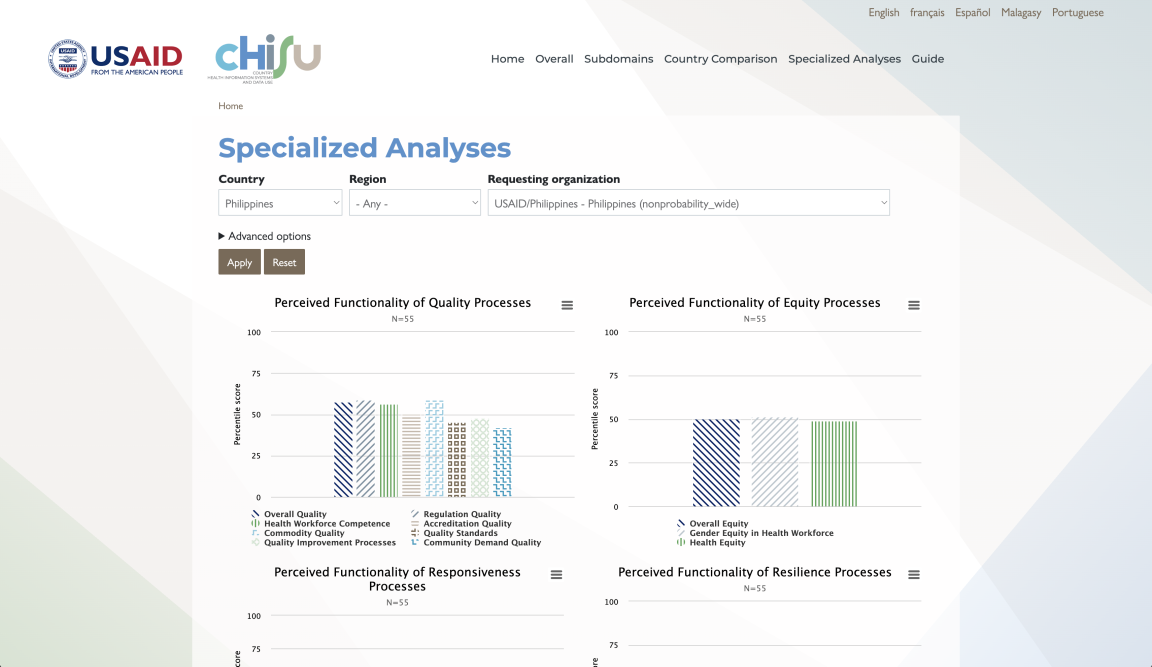On March 30, USAID and CHISU hosted a webinar titled: “Commonalities and Differences in Ethiopia, Madagascar, and Philippines HPHC Tool Health System Assessments.” The webinar was the first in our series that shares learnings from health system assessments using the High Performing Health Care (HPHC) Tool in low- and middle-income countries (LMICs).
Steve Ollis, Program Director for CHISU, moderated the discussion with panelists:
- Dr. Mai Hijazi, Director, Office of Health Systems, Bureau for Global Health, USAID
- Dr. Joseph Anthony Lachica, Project Management Specialist, Health Office, USAID/Philippines
- Ms. Lova Avotra Ralijaona, Health Management Information System and Monitoring and Evaluation Specialist, Health Office, USAID/Madagascar
- Dr. Diana Ratsiambakaina, Director, Universal Health Coverage Implementation Support Unit, Ministry of Health, Madagascar
- Dr. Helina Worku, Deputy Director, Health Office, USAID/Ethiopia
Dr. Hijazi set the stage by providing background on the tool and rationale for its creation. She noted that the Office of Health Systems launched the tool in 2021 to contribute to fulfilling the need around measuring health system performance. “The tool allows for timely decision making through real-time data analysis and visualization,” she stated, adding that the tool “is participatory and low-cost to implement.”
The HPHC Tool uses stakeholder perceptions to evaluate existing health system processes. Each country also compared the tool’s results to other data sources—not only for triangulation of the data, as Dr. Lachica explained, but for describing the tool’s reliability and validity. After using the tool, Ethiopia, Madagascar, and the Philippines all had overall scores below 50 percent, and across the four domains that the tool measures (accessibility, accountability, affordability, and reliability), affordability had the lowest score for each of the three countries.
Each of the panelists discussed how the tool helped them identify parts of the health system that were working well and other parts that were working less well. Some of the domains the tool helped analyze included insurance coverage, health facility access, respectful health care, equity, cost of care, use of digital health, and interoperable and routine information systems.
Dr. Lachica explained that for the Philippines, the health system weaknesses identified by the HPHC tool were challenges that they were already aware of—but seeing the results of the tool gave them the foundation of evidence needed for citing in future program planning.
“The tool allowed us to zero in on critical components of the health system that need to be strengthened,” he said.

Dr. Ratsiambakaina described Madagascar’s use of the tool as having a similar role in the assessment and planning process. “It helped the Ministry of Health go back and see what can be done, what can be improved to have better services for the population—and particularly that it’s accessible for everybody, that it’s available,” she said.
In Ethiopia, the tool also facilitated a better understanding of the health system’s constituent parts.
“This tool really helps us understand the interrelationships and interactions between the different health system functions,” Dr. Worku said. She explained that this understanding of these interactions helps us see that health system performance is more than just the sum of its parts’ functionalities.
Going forward, the HPHC tool will continue to evolve based on countries’ needs and ideas for improvement. Panelists shared recommendations for the tool based on feedback from various stakeholders, including ideas from Madagascar around including open-ended questions in the tool and providing offline tool access for countries with internet connectivity issues. In Ethiopia, there was a desire to conduct this assessment on a yearly basis to see if program implementation influenced health system performance as well as a desire to translate the tool into specific local languages.
USAID and CHISU will share experiences of countries using the HPHC Tool in Bangladesh, Colombia, East Timor, Ghana, Kenya, and Mozambique in upcoming webinars.